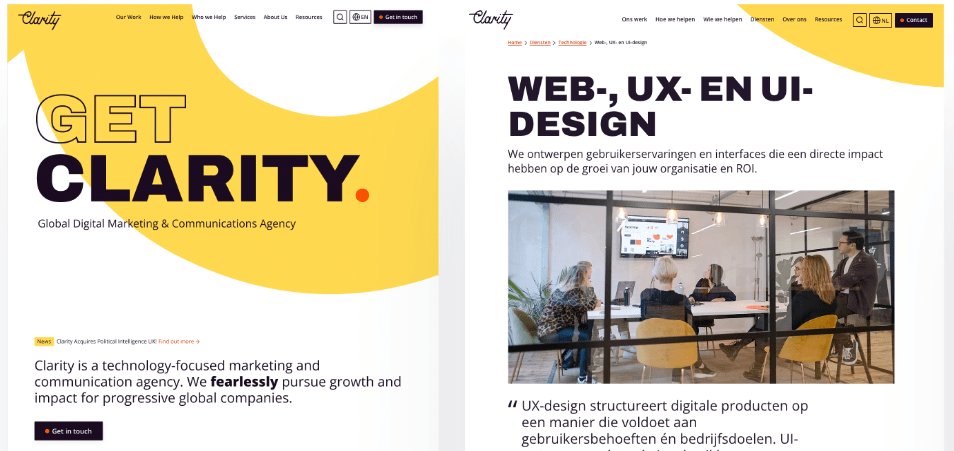Applying the Pareto Principle to website redesign & builds

There are many triggers behind why a company decides to redesign their website. It could be to improve user experience, to reflect an updated brand and create standout, improve performance or it could be to highlight additional service offerings following an acquisition. Or it could be all of them.
The underlying motivation is of course the ‘bottom line’ – increasing sales, revenue and driving business growth. The key barrier is the time and budget available. Therefore with the drive to deliver ‘more for less’, where should you focus attention and budget when it comes to briefing a website redesign and build?
The answer may have its origins in a pea garden…
What do peas and websites have in common?
Around the early 1900s, the economist Vilfredo Pareto noticed that 20% of the pea pods in his garden were producing 80% of the crop. A few years later, he noticed a similar pattern in the world of macroeconomics when he observed that 80% of the land in Italy was owned by only 20% of the population.
Over time, this thinking developed to become known as the Pareto Principle and has been applied to other areas such as business management & operations, investments (interesting article here on Investopedia) and of course website production.
The Pareto Principle suggests that 20% of your efforts produce 80% of your results.

5 ways the Pareto Principle could be applied to help guide a website project
When you apply this way of thinking to the process of planning, designing and building a website, it can help you focus attention on the features that will make the biggest impact, and therefore deliver a much more efficient and effective website.
Identify the high impact features
The first step is to be clear on the site’s objectives. What do you want the site to deliver? What metrics and KPIs need to be in place to ensure performance against these objectives can be tracked? This is a cornerstone of our discovery (ie planning) phase and helps to identify which features of the website will yield the most significant benefits.
These are the 20% that will contribute to 80% of the site’s success.
High-impact features might include user-friendly navigation, faster page loading times, mobile optimization, and structured & engaging content. By prioritizing these key aspects, our designers and developers can concentrate their efforts where it’s most effective, and reduce the time and effort spent on less influential elements.
This is a key feature of our discovery & definition phase.
Focusing on User Experience
At the heart of the Pareto Principle’s application in web design is enhancing user experience. Given that a small proportion of a website’s features may account for the majority of a user’s engagement, identifying and refining these aspects is super important.
For example, optimizing the checkout process on an e-commerce site can significantly boost conversion rates, far more than tweaking the colour scheme of the footer ever could. Similarly, ensuring the site is mobile-friendly and call to actions are clear and accessible, will help enhance the reach and effectiveness of your website.
Strategic Content Creation
When it comes to content, the Pareto Principle suggests that most of your website’s value will come from just a fraction of your content. Identifying the types of content that resonate most with your audience—be it thought leadership, reports, or service descriptions—can guide a more strategic approach to content creation. This means investing more resources in developing high-quality content in these key areas, rather than spreading your efforts too thinly across less impactful content types.
Our SEO and content studio can help with content audits, content strategy and copywriting.
Streamlining Development Processes
Applying the 80:20 rule can also streamline development processes by identifying which tasks & features are crucial and which can be simplified or removed. This approach can drastically reduce development time and costs, especially in testing, allowing resources to be allocated more efficiently. For instance, focusing on developing a robust core website and the most important features, rather than trying to include ‘nice-to-have’ functionality from the start, can lead to far quicker launch times and better allocation of development resources.
Prioritizing Features for Continuous Improvement
Post-launch, the 80:20 rule can help guide continuous improvement efforts. By analyzing user data and feedback, our team can help monitor and identify which features are most used and valued by users, and which ones don’t add significant value. This data-driven approach allows for focusing on optimizing and expanding the 20% of features that generate the most user engagement and satisfaction, rather than expending resources on less impactful areas.
Our CRO service can help with this.
Conclusion
In website design and build, applying the Pareto Principle can help focus attention on the features that will deliver your business the most value. doing more with less. It is about identifying and focusing on the critical 20% of efforts that will yield 80% of the website’s value and success. This approach not only streamlines development and optimizes resources but also ensures that the end product is user-centric and highly effective.
By applying the 80:20 rule throughout the website design and build process, from initial planning and design through to development support & continuous improvement post-launch, you can create more impactful, efficient, and successful websites.
Who would have thought a field full of pea pods could potentially be the key to helping you deliver more for less.

How to use heat mapping for conversion rate optimisation

The potential of WordPress as a Headless CMS
Let's Talk
Do you have a web design and build project coming up that you would like to talk about?